#gavin finney
Text
Oooh! A great Gavin Finney (Good Omens Director of Photography) interview with Helen Parkinson for the British Cinematographer! :)
HEAVEN SENT
Gifted a vast creative landscape from two of fantasy’s foremost authors to play with, Gavin Finney BSC reveals how he crafted the otherworldly visuals for Good Omens 2.
It started with a letter from beyond the grave. Following fantasy maestro Sir Terry Pratchett’s untimely death in 2015, Neil Gaiman decided he wouldn’t adapt their co-authored 1990 novel, Good Omens, without his collaborator. That was, until he was presented with a posthumous missive from Pratchett asking him to do just that.
For Gaiman, it was a request that proved impossible to decline: he brought Good Omens season one to the screen in 2019, a careful homage to its source material. His writing, complemented by some inspired casting – David Tennant plays the irrepressible demon Crowley, alongside Michael Sheen as angel-slash-bookseller Aziraphale – and award-nominated visuals from Gavin Finney BSC, proved a potent combination for Prime Video viewers.
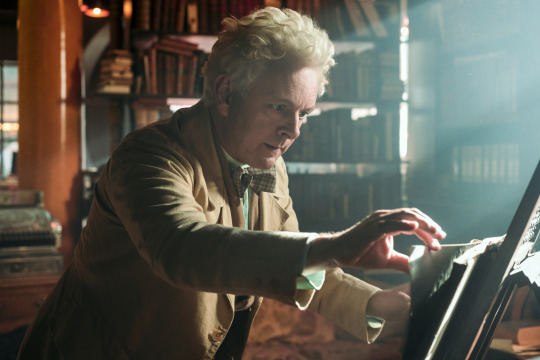
Aziraphale’s bookshop was a set design triumph.
Season two departs from the faithful literary adaptation of its predecessor, instead imagining what comes next for Crowley and Aziraphale. Its storyline is built off a conversation that Pratchett and Gaiman shared during a jetlagged stay in Seattle for the 1989 World Fantasy Convention. Gaiman remembers: “The idea was always that we would tell the story that Terry and I came up with in 1989 in Seattle, but that we would do that in our own time and in our own way. So, once Good Omens (S1) was done, all I knew was that I really, really wanted to tell the rest of the story.”
Telling that story visually may sound daunting, but cinematographer Finney is no stranger to the wonderfully idiosyncratic world of Pratchett and co. As well as lensing Good Omens’ first outing, he’s also shot three other Pratchett stories – TV mini series Hogfather (2006), and TV mini-series The Colour of Magic (2008) and Going Postal (2010).
He relishes how the authors provide a vast creative landscape for him to riff off. “The great thing about Pratchett and Gaiman is that there’s no limit to what you can do creatively – everything is up for grabs,” he muses. “When we did the first Pratchett films and the first Good Omens, you couldn’t start by saying, ‘Okay, what should this look like?’, because nothing looks like Pratchett’s world. So, you’re starting from scratch, with no references, and that starting point can be anything you want it to be.”

Season two saw the introduction of inside-outside sets for key locations including Aziraphale’s bookshop.
From start to finish
The sole DP on the six-episode season, Finney was pleased to team up again with returning director Douglas Mackinnon for the “immensely complicated” shoot, and the pair began eight weeks of prep in summer 2021. A big change was the production shifting the main soho set from Bovington airfield, near London, up to Edinburgh’s Pyramids Studio. Much of the action in Good Omens takes place on the Soho street that’s home to Aziraphale’s bookshop, which was built as an exterior set on the former airfield for season one. Season two, however, saw the introduction of inside-outside sets for key locations including the bookshop, record store and pub, to minimise reliance on green screen.
Finney brought over many elements of his season one lensing, especially Mackinnon’s emphasis on keeping the camera moving, which involved lots of prep and testing. “We had a full-time Scorpio 45’ for the whole shoot (run by key grip Tim Critchell and his team), two Steadicam operators (A camera – Ed Clark and B camera Martin Newstead) all the way through, and in any one day we’d often go from Steadicam, to crane, to dolly and back again,” he says. “The camera is moving all the time, but it’s always driven by the story.”
One key difference for season two, however, was the move to large-format visuals. Finney tested three large-format cameras and the winner was the Alexa LF (assisted by the Mini LF where conditions required), thanks to its look and flexibility.
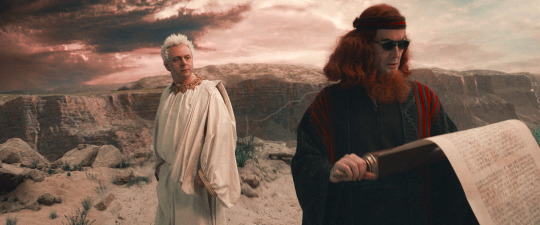
The minisodes were shot on Cooke anamorphics, giving Finney the ideal balance of anamorphic-style glares and characteristics without too much veiling flare.
A more complex decision was finding the right lenses for the job. “You hear about all these whizzy new lenses that are re-barrelled ancient Russian glass, but I needed at least two full sets for the main unit, then another set for the second unit, then maybe another set again for the VFX unit,” Finney explains. “If you only have one set of this exotic glass, it’s no good for the show.”
He tested a vast array of lenses before settling on Zeiss Supremes, supplied by rental house Media Dog. These ticked all the boxes for the project: “They had a really nice look – they’re a modern design but not over sharp, which can look a bit electronic and a bit much, especially with faces. When you’re dealing with a lot of wigs and prosthetics, we didn’t want to go that sharp. The Supremes had a very nice colour palette and nice roll-off. They’re also much smaller than a lot of large-format glass, so that made it easy for Steadicam and remote cranes. They also provided additional metadata, which was very useful for the VFX department (VFX services were provided by Milk VFX).”
The Supremes were paired with a selection of filters to characterise the show’s varied locations and characters. For example, Tiffen Bronze Glimmerglass were paired with bookshop scenes; Black Pro-Mist was used for Hell; and Black Diffusion FX for Crowley’s present-day storyline.

Finney worked closely with the show’s DIT, Donald MacSween, and colourist, Gareth Spensley, to develop the look for the minisode.
Maximising minisodes
Episodes two, three and four of season two each contain a ‘minisode’ – an extended flashback set in Biblical times, 1820s Edinburgh and wartime London respectively. “Douglas wanted the minisodes to have very strong identities and look as different from the present day as possible, so we’d instantly know we were in a minisode and not the present day,” Finney explains.
One way to shape their distinctive look was through using Cooke anamorphic lenses. As Finney notes: “The Cookes had the right balance of controllable, anamorphic-style flares and characteristics without having so much veiling flare that they would be hard to use on green screens. They just struck the right balance of aesthetics, VFX requirements and availability.” The show adopted the anamorphic aspect ratio (2:39.1), an unusual move for a comedy, but one which offered them more interesting framing opportunities.
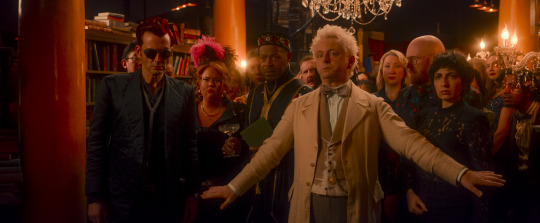
Good Omens 2 was shot on the Alexa LF, paired with Zeiss Supremes for the present-day scenes.
The minisodes were also given various levels of film grain to set them apart from the present-day scenes. Finney first experimented with this with the show’s DIT Donald MacSween using the DaVinci Resolve plugin FilmConvert. Taking that as a starting point, the show’s colourist, Company 3’s Gareth Spensley, then crafted his own film emulation inspired by two-strip Technicolor. “There was a lot of testing in the grade to find the look for these minisodes, with different amounts of grain and different types of either Technicolor three-strip or two-strip,” Finney recalls. “Then we’d add grain and film weave on that, then on top we added film flares. In the Biblical scenes we added more dust and motes in the air.”
Establishing the show’s lighting was a key part of Finney’s testing process, working closely with gaffer Scott Napier and drawing upon PKE Lighting’s inventory. Good Omens’ new Scottish location posed an initial challenge: as the studio was in an old warehouse rather than being purpose-built for filming, its ceilings weren’t as high as one would normally expect. This meant Finney and Napier had to work out a low-profile way of putting in a lot of fixtures.
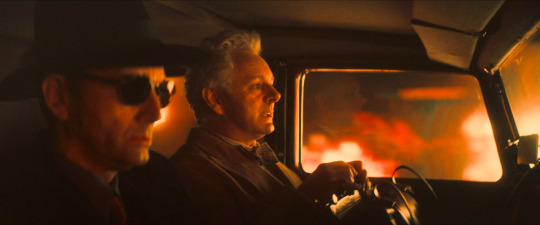
Inside Crowley’s treasured Bentley.
Their first task was to test various textiles, LED wash lights and different weight loadings, to establish what they were working with for the street exteriors. “We worked out that what was needed were 12 SkyPanels per 20’x20’ silk, so each one was a block of 20’x20’, then we scaled that up,” Finney recalls. “I wanted a very seamless sky, so I used full grid cloth which made it very, very smooth. That was important because we’ve got lots of cars constantly driving around the set and the sloped windscreens reflect the ceiling. So we had to have seamless textiles – PKE had to source around 12,000 feet of textiles so that we could put them together, so the reflections in the windscreens of the cars just showed white gridcloth rather than lots of stage lights. We then drove the car around the set to test it from different angles.”
On the floor, they mostly worked with LEDs, providing huge energy and cost savings for the production. Astera’s Titan Tubes came in handy for a fun flashback scene with John Hamm’s character Gabriel. The DP remembers: “[Gabriel] was travelling down a 30-foot feather tunnel. We built a feather tunnel on the stage and wrapped it in a ring of Astera tubes, which were then programmed by dimmer op Jon Towler to animate, pulse and change different colours. Each part of Gabriel’s journey through his consciousness has a different colour to it.”
Among the rigs built was a 20-strong Creamsource Vortex setup for the graveyard scene in the “Body Snatchers” minisode, shot in Stirling. “We took all the yokes off each light then put them on a custom-made aluminium rig so we could have them very close. We put them up on a big telehandler on a hill that gave me a soft mood light, which was very adjustable, windproof and rainproof.”

Shooting on the VP stage for the birth of the universe scenes in episode one.
Sky’s the limit
A lot of weather effects were done in camera – including lightning effects pulsed in that allowed both direct fork lightning and sheet lightning to spread down the streets. In the grade, colourist Spensley was also able to work his creative magic on the show’s skies. “Gareth is a very artistic colourist – he’s a genius at changing skies,” Finney says. “Often in the UK you get these very boring, flat skies, but he’s got a library of dramatic skies that you can drop in. That would usually be done by VFX, but he’s got the ability to do it in Baselight, so a flat sky suddenly becomes a glorious sunset.”
Finney emphasises that the grade is a very involved process for a series like Good Omens, especially with its VFX-heavy nature. “This means VFX sequences often need extra work when it comes back into the timeline,” says the DP. “So, we often add camera movement or camera shake to crank the image up a bit. Having a colourist like Gareth is central to a big show like Good Omens, to bring all the different visual elements together and to make it seamless. It’s quite a long grade process but it’s worth its weight in gold.”


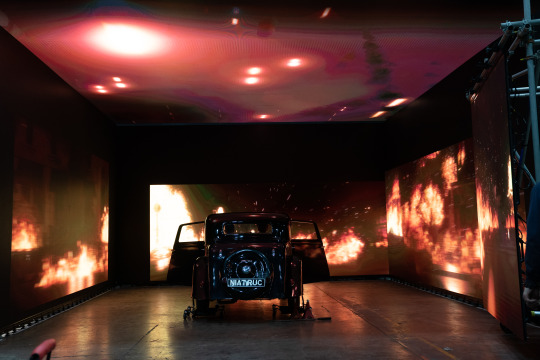
Shooting in the VR cube for the blitz scenes .
Finney took advantage of virtual production (VP) technology for the driving scenes in Crowley’s classic Bentley. The volume was built on their Scottish set: a 4x7m cube with a roof that could go up and down on motorised winches as needed. “We pulled the cars in and out on skates – they went up on little jacks, which you could then rotate and move the car around within the volume,” he explains. “We had two floating screens that we could move around to fill in and use as additional source lighting. Then we had generated plates – either CGI or real location plates –projected 360º around the car. Sometimes we used the volume in-camera but if we needed to do more work downstream; we’d use a green screen frustum.” Universal Pixels collaborated with Finney to supply in-camera VFX expertise, crew and technical equipment for the in-vehicle driving sequences and rear projection for the crucial car shots.

John Hamm was suspended in the middle of this lighting rig and superimposed into the feather tunnel.
Interestingly, while shooting at a VP stage in Leith, the team also used the volume as a huge, animated light source in its own right – a new technique for Finney. “We had the camera pointing away from [the volume] so the screen provided this massive, IMAX-sized light effect for the actors. We had a simple animation of the expanding universe projected onto the screen so the actors could actually see it, and it gave me the animated light back on the actors.”
Bringing such esteemed authors’ imaginations to the screen is no small task, but Finney was proud to helped bring Crowley and Aziraphale’s adventures to life once again. He adds: “What’s nice about Good Omens, especially when there’s so much bad news in the world, is that it’s a good news show. It’s a very funny show. It’s also about good and evil, love and doing the right thing, people getting together irrespective of backgrounds. It’s a hopeful message, and I think that that’s what we all need.”
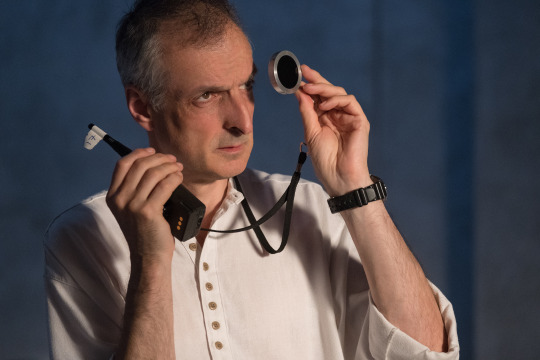
Finney is no stranger to the idiosyncratic world of Sir Terry Pratchett and Neil Gaiman.
#good omens#gos2#season 2#interview#gavin finney#neil gaiman#terry pratchett#gavin finney interview interview#s2 interview#bts#fun fact#british cinematographer#british cinematographer 2023#jon hamm#2ep1#2ep2#2ep3#2ep4#2ep6#2i1i1#job's minisode#1941 minisode#1827 minisode#2i6i7#bentley
2K notes
·
View notes
Text

Michael and David are "so strong and so real and true."
This is fine. I'm fine...
#good omens#michael sheen#welsh seduction machine#david tennant#soft scottish hipster gigolo#gavin finney#is now right up there with rob wilkins#'so strong and so real and true'#i can't#that thing where two people are in love and meant to be together#also art imitating life#or vice versa#or both#tell me again that they're not a couple#at this point the subtext might as well be a billboard#ineffable lovers#i need to lie down now
1K notes
·
View notes
Text







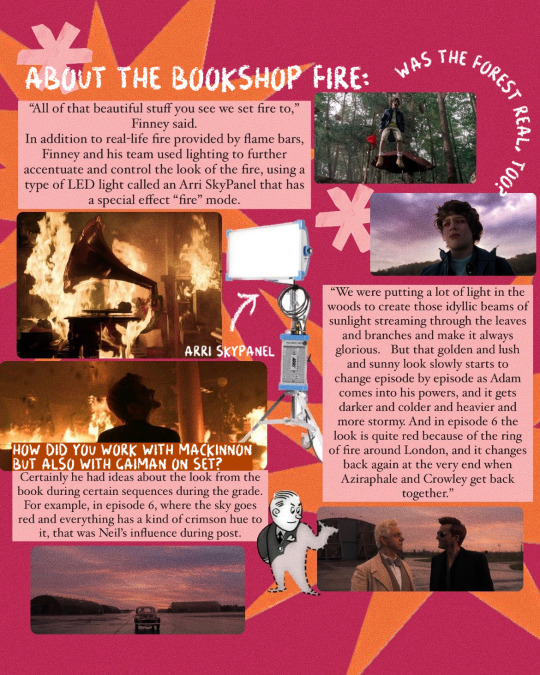


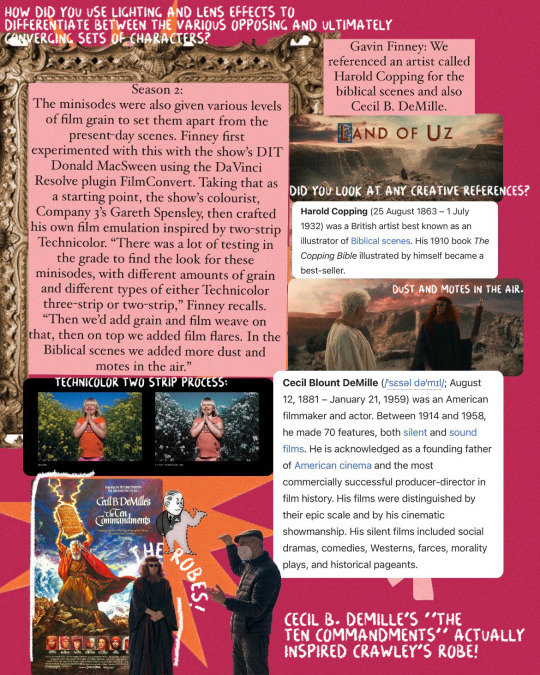





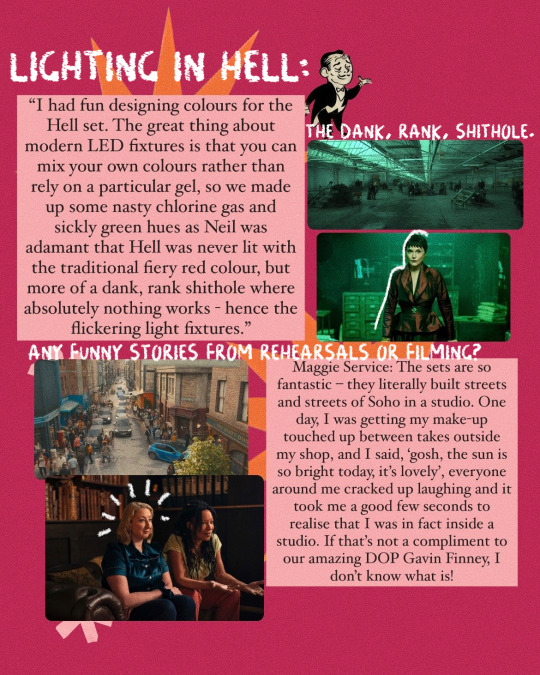
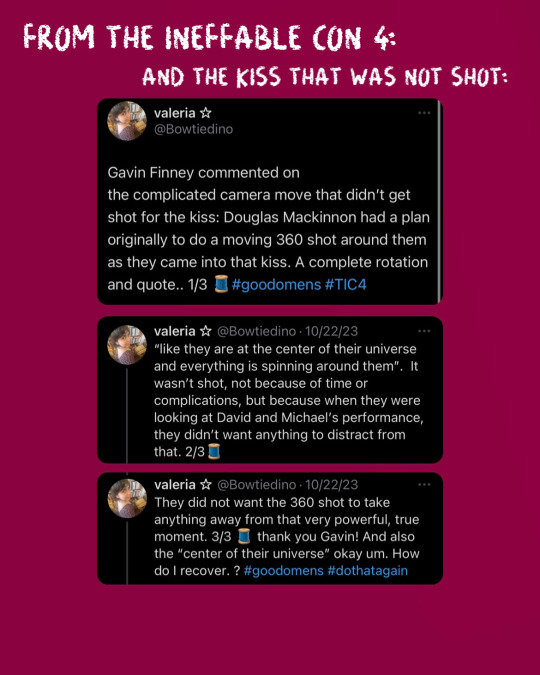

Good Omens: behind the camera!
With DoP Gavin Finney.
I gathered together all of the interviews I could find where Gavin Finney discusses his work for Good Omens: including how he framed certain shots, the filters used for some scenes, how Aziraphale has a constant halo and celestial shots. (Even a camera that only exists for filming the Gavotte).
There are even more things dealing with CGI and VFX in the articles. So do give them a read if you can!
I also added some things he mentioned for The Ineffable Con 4.
Here are all of my sources:
British Cinematographer Season 1
Good Omens DP Gavin Finney on Earthly and Otherwordly In-Camera Delights
British Cinematographer Season 2
How Cinematographer Gavin Finney Brought Heaven and Hell to Life in ‘Good Omens’
DP Chat: Good Omens cinematographer Gavin Finney
Definition Magazine: Raining Men, Omen
On Shooting Good Omens
Maggie Service: ‘The Good Omens Universe Is A Lovely Place To Inhabit’ – Interview
Tweets because I do now know how to call them anymore:
About the kiss.
Blurring the edges.
Intentional Lighting.
#good omens#aziraphale#crowley#ineffable husbands#neil gaiman#terry pratchett#good omens fun facts#good omens 2#easter eggs#gavin finney#cinematography#film stills#good omens behind the scenes
372 notes
·
View notes
Text
Some highlights of the panel with Gavin Finney at @theineffablecon.
Gavin Finney is the director of photography on Good Omens.
Feel free to add things in the replies if you think we’ve missed something.
- He says that Good Omens is a very fun show to work on where you can really let your imagination go.
- One of the challenges with season 2 was to top season 1.
- Everything we see on screen is real. In season 1, the bookshop was designed to be flammable. (Edit- Note: this about the props and the details put in the creation of the sets).
- About the complicated camera move planned for the kiss scene: the plan was to have a moving 360 shot to highlight the fact that Aziraphale and Crowley are at the centre and everything around them is spinning. But the performance was simply so amazing that they didn’t want to take away from that with a fancy camera move so they decided to keep it simple. He also explains that the kiss is an example of something simple that works beautifully. The lighting was done on purpose.
- With season 2 it was possible to control the weather (scene where Crowley creates a storm). The change in weather also contributed to show a change in mood (Aziraphale’s, for instance, with bright and shiny weather when he’s happy).
- His favourite sets are the magic shop (full of wonderful props and tricks), the bookshop (designed to be the loveliest bookshop in London) and the Dirty Donkey pub.
- When it comes to do things on camera vs in post production: they tried to do as much as possible on camera (Hell was mostly on camera). Scenes looking down the street or Heaven are made/adjusted in post-production.
- About the minisodes: Neil and Douglas wanted them to be as different as possible from present day so that they would be their own self contained thing. To show that they used different camera lenses were (anamorphic lenses). The minisode with Job had a religious painting aspect, the 1827 Scotland one had a gothic/foggy aspect and the Blitz one was meant to be the epitome of film noir.
- The colours in S2 look more vibrant because they used a different camera system that captures more light and higher resolution. It’s also a result of post production colour grading.
@neil-gaiman
424 notes
·
View notes
Text
Bullet Theory
Thesis: Crowley passed Aziraphale a bullet during the Final Fifteen kiss. This bullet contains his memories. He tucked it under his tongue, then began to access the memories during the ride up the elevator.
Edit: debunked by God himself, in response to this post. As a reminder, please don’t send fan theories to NG.
Proof:
Glint in the mouth
Inspo credit to this post by @somehow-a-human
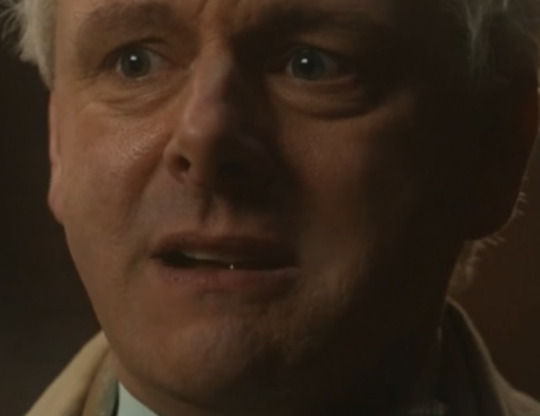
Yeah so we were already paying way too much attention to that very special four-letter word we thought Aziraphale was going to say, but it so happens that during that cut-off phoneme is the only time you can see this shiny object in his mouth. (catching this on the right frame was emotionally painful and I’m sending Gavin Finney my therapy bills (actually no I’m not I love you very much sir)).
So that’s the basis of this theory. Crowley passed Aziraphale a bullet that he then tucks under his tongue.
Add’l Evidence Post-Kiss
Aziraphale works his jaw after raising his fingers to his lips: [gif]

Then when the Metatron comes in, he turns his back on the Metatron and raises his hand. I originally thought he was wiping his eyes. Now I think he’s raising his hand to his mouth, maybe to spit out the bullet, maybe to make sure it’s secured under his tongue.
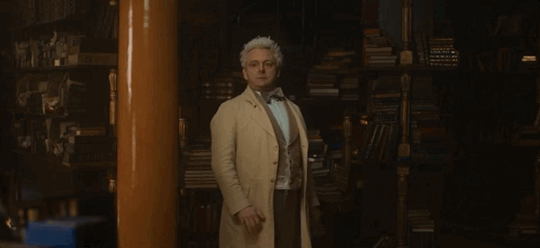
Credits Scene
Aziraphale has the craziest fucking look on his face through the credits, we can all agree. But towards the end, his eyes flicker back and forth, as if he is watching or reading something. Then he smiles. I hypothesize that he is still accessing his memories during this time, and getting the information he needs to [redacted].
Thematic Justification: The Bullet Catch
Aziraphale having a bullet in his mouth as part of a two-man act of deception is not a fresh concept by the time we get to The Final Fifteen.
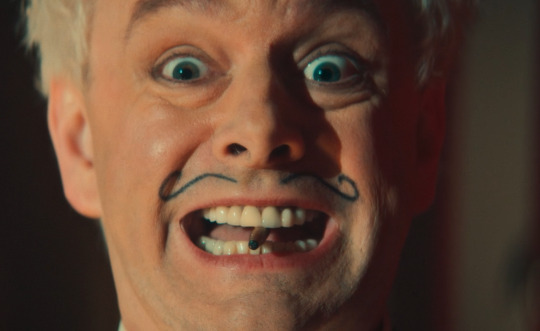
Additionally, the use of surreptitious modes of communication, where messages are passed from person to person inaudabily, is introduced in this same magic trick.
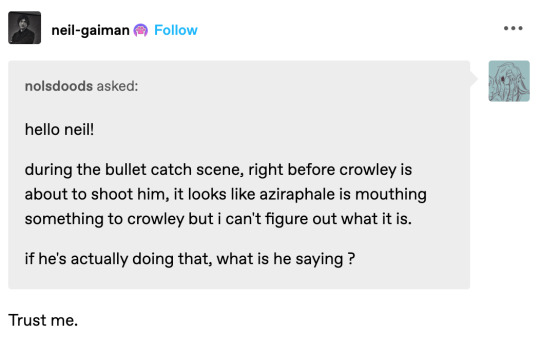
NB1: I wish I could credit the person who I first saw point this out (relatively recently). It wasn’t even tagged as meta, I don’t think. But the gist was there’s some parallelism between “aim for my mouth but shoot past my ear” and the “pin the lips on the lips” move that Crowley pulls in the Final Fifteen. If I find it I will properly cite.
NB2: One hypothesis that has circulated around, I think creditable to @sendarya, is that Aziraphale mouths “trust me” to Crowley just before he gets on the elevator. This isn’t necessary to the Bullet Theory but it would be thematically consistent.
Small objects carry memories
Why a bullet? Well, it’s a small object that has meaningful significance between the pair of people involved, much like:
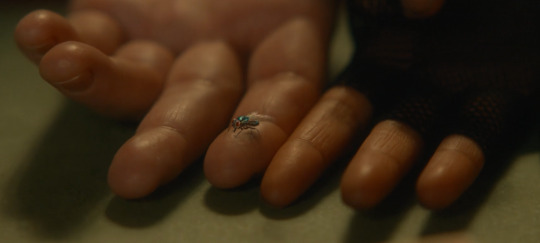
Beelzebub introduces us to the idea that a small object like a fly can be used as a storage container for memories. We also see that the object entering the body of the person is a viable way for the memories to be delivered.
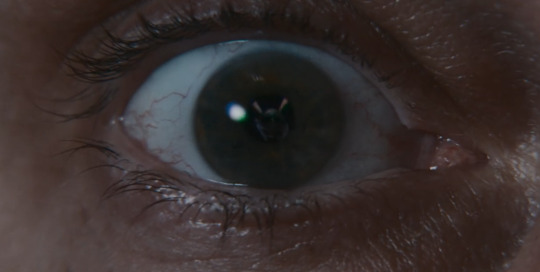
(btw Jon Hamm if you’re reading this, you have very pretty eyes)
“I keep a derringer in a hollowed out book”
K, so it’s not like Crowley is just carrying a bullet loaded with Aziraphale’s memories around with him at all times, is it? (I mean, it could be, but probably not. I’ll just point you to this meta for my theories on why, if Crowley had anything that needed to be kept safe, he would keep it in the bookshop.)
We learn in S2E4 that Aziraphale keeps a gun in a hollowed out book somewhere in the shop. A gun wouldn’t be any good without bullets, right? This may not be the reason the derringer was left as a Chekhov’s Gun for S3, but it’s a possibility. If Crowley wasn’t already in possession of a bullet, he knew that he could find one in the shop. Even more likely, the exact bullet used in the 1941 magic trick is a precious keepsake being kept somewhere in the bookshop, and Crowley chose to use that exact bullet because of the memories already directly attached to the object.
Why Aziraphale even has memories to be returned to him
We know that Aziraphale could have had his mind wiped because Heaven has done it before. Certainly once. Probably twice. We know this because when Metatron is announcing that Gabriel, alongside having his memories erased, is being demoted to 38th class, Muriel pipes up and reminds us that they are 37th class:

So this wasn’t a “just Gabriel” thing. Mind-wiping is a routine form of personnel management in Heaven. There is NO reason for us to believe that it didn’t happen to Aziraphale. But in case you need a reason to believe it, here goes:
We know from our interactions with Jim that the person whose memories are missing (1) doesn’t necessarily know and (2) isn’t necessarily distressed by that fact, even if they do. Muriel also fits this “cheerful empty shell” archetype. You know who else does? Ding ding ding. The one and only A. Z. “wiggles with delight” Fell.
I can already hear your very valid counter-argument. This guy is actually terrified out of his mind on any given day that his romance with a demon will be discovered. Yes. Because he’s involved in a romance with a demon. The other two angels we’ve met don’t have this issue. Beyond that, though, these three characters share more in common with each other disposition-wise than any of them do with the other angels we’ve met (Uriel, Michael, Sandolphon, etc.).
We also know that Aziraphale has been [demoted] at some point from Cherub to Principality. This is book canon:
"Technically Aziraphale was a Principality, but people made jokes about that these days."
This has also been confirmed (insofar as Neil Gaiman ever confirms anything) by Word of God:
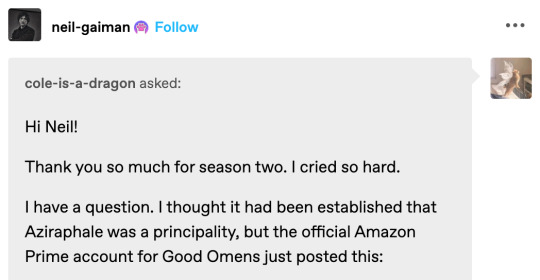
(marketing video screengrab clipped for brevity)
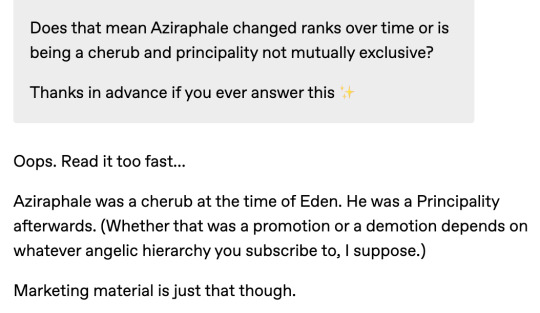
We don’t know for sure it was a demotion, but I think we have enough evidence to infer that with a high degree of confidence.
Anyways.
Summary: Aziraphale is a cheerful angel who was demoted and has a name that is not biblical canon. This evidence indicates that was probably mind-wiped. This is not the first time I’m proposing this. It won’t be the last.
How Crowley Did It
My meta on Continuity Errors gives the complete proof for why I believe that Crowley is able to stop time without Aziraphale knowing, and I propose in that meta that the kiss was a cover-up for the exertion of effort necessary to pull that off. I further proposed that during the pause, he retrieved something from the bookshop. At the time of writing, I didn’t know what. Now, I have an inkling that it was a bullet.
If you need a refresher on Clock Theory, here’s one. The idea is that the clock behind Aziraphale shifts by fifteen minutes from before the kiss to after the kiss. This is consistent with a theory that Crowley paused time (but the clock kept running) in order to retrieve the bullet, dump Aziraphale’s memories into it if he hadn’t already, and then return to transfer the bullet to Aziraphale.
Why Crowley Kept the Secret So Long
As with Continuity Errors, I am ending this meta with a very unsatisfactory “I don’t know.” The motivation for Crowley to keep Aziraphale’s memories from him until the very moment he’s about to leave must have been a strong one. I think it has something to do with why Crowley was so insistent on trying to get Aziraphale to run away with him, instead of dealing with whatever’s coming. But as with Continuity Errors, I suspect that the good omens meta hivemind (and the vast collection of people who are posting clues, you have no idea how important you are) will assemble yet more breadcrumbs that we can follow to some sort of hypothesis.
Until then,
iv
(here's my meta index if you would like to read more stuff like this)
#good omens meta#bullet theory#the final fifteen#crowley#aziraphale#good omens gabriel#good omens muriel#good omens#good omens 2#ineffable husbands#good omens theory#good omens speculation#good omens analysis#good omens clues
341 notes
·
View notes
Text
Whose POV is it anyway?
An Introduction
DO NOT ASK NEIL ABOUT FAN THEORY
Cracking down on the storytelling of Good Omens season 2 through the lens of a changing narrator.
If you haven't read this interview with Good Omens cinematographer Gavin Finney, and you're interested in the fantastic dedication and detail that went into this TV show, definitely give it a read. Not only is it lovely, but Neil also posted the article with a caption mentioning that it's got so many secrets in it. Obviously that made me take a closer look.
I have already gone into a fair bit of detail about the different Lens Filters that Finney mentions in the article in a separate post and I will be referring to them quite a bit so if you aren't familiar with them I would suggest reading that first!
This first post is going to cover the basics of changing narrator/POV's and I'll be writing additional posts for separate episodes/minisodes/scenes since there's obviously way too much to cover in a single go. So shall we take our first look?
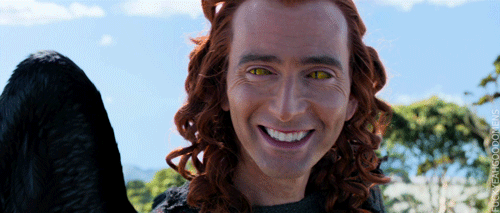
It's no secret that something's a *bit weird* with season two, and there are SO many theories about it. I love to read speculation, metas, theories, and opinions, it's definitely fun but my personal ideas align more with the idea that we're simply being shown the events of season 2 through the memories of multiple narrators, different POV's, and it slightly skews the story, sometimes within one continuous scene.
I am also a sucker for a good multiple timeline theory but that isn't this post.
Lens Filters
As I stated above, I wrote a post about each of these individual filters earlier. What I didn't go into in that post was speculation about the filters. While I think they're pretty straightforward, especially the filter for hell (Black Pro-Mist ((BPM)), I think the other two have a bit more room for speculation.
Bronze Glimmer Glass
BGG was described by Finney as being used for 'bookshop scenes', but after S2 back numerous times and paying as much attention as I could to the lighting and colouring of the scenes, I think this is generally true but not always true. There are times when bookshop scenes seem to use a different filter, and other locations also seem to be shot with the BGG filter as well. I think BGG aligns with Aziraphale's POV. Or if Not Aziraphale, an outside-of-Crowley narrator? Based on the scenes (which we'll specifically get into in other posts) which BGG seems to be used, context clues, character behavior, etc, I think BGG clues us in that we're seeing, if you will, through Aziraphale's eyes.
Black Diffusion FX
BDFX was described as being used for 'Crowley's present day storyline' and fuck me, that's not ominous or weirdly phrased at all Mr. Finney! This filter definitely aligns with Crowley. Most of the time he's separate from Aziraphale it seems that this is the filter being used, and certain scenes switch filters mid-scene when he begins to go off on snarky Crowley-centric commentary.
Catch-22 & Herzog
The books on Gabriels bookshelf, great books obviously, but I think books that are also meant to give us context about the story. Pride and Prejudice is a love story about making snap judgements on someone's character, and coming to recognize somebody might be good despite their title or appearance. The Crow Road is a story about life, death, love, morality, mystery, and God. 1984 details the tragedy of Julia and Winston's attempt at falling in love while living under in a police state. You see my point?
That's why I wanted to touch a bit more on Catch-22 and Herzog specifically when talking about the possibility of changing narrators/POV's in Good Omens 2.
Catch-22 frequently switches narrator and the events described are often not necessarily sequential. This way you're getting information about previous scenes as the story continues, so while you're reading the book you're forming a more complete image of the events as the story continues from different characters POV's and iterations of the story. Sound relevant?
Herzog is the other book I wanted to talk about. To be fair I haven't read Herzog in full like I have Catch-22 but I pulled out my copy to reference and flip through a bit to remind myself. Herzog unlike Catch-22 doesn't switch narrators but the narration by the main character, Herzog himself, switches between first and third person throughout. When he is narrating through his letters, you get a deeper look at his thought processes and emotions. It also relies on flashbacks to bring context to the life of Herzog.
While these books touch on other elements that are relevant to the Good Omens story, namely Yossarian's relationship and views of God in Catch-22, the way these stories are told intrigued me for this context.
Crowley's Hair
Yeah I'm gonna mention the hair, because I think the hair is linked. Crowley's shorter sideburns, trimmed mutton chops in the 1827 flashback, and shorter Job wig seem to be clearly aligned with the BDFX filter/Crowley's POV as far as I can tell. I don't know if this means it's just another way to denote POV, but it seems way too consistent not to mention it. The longer sideburns, fuller mutton chops, and longer Job wig all match up with Aziraphale's POV or the BGG filter. My thoughts here are that his hair is another hint of who may be relaying the information to us, AKA is it internal or external. I am making my best guesses though and there are still some situations that I feel less sure about. For example, when Aziraphale takes the Bentley to Edinburgh and Crowley is in the Bookshop with Jim his sideburns are long, is it because he's remembering these scenes unreliably? Is Aziraphale imagining the events? Is it because Jim is present? A brief fluttering thought I toy with from time to time is the fact that in the before-the-beginning scene they are long, and what that means in context of the rest of the season.
S2 Promo Posters
Finally this set of season 2 promo posters showing the characters thoughtfully considering scenes in their heads just gives me a lot of these POV vibes.

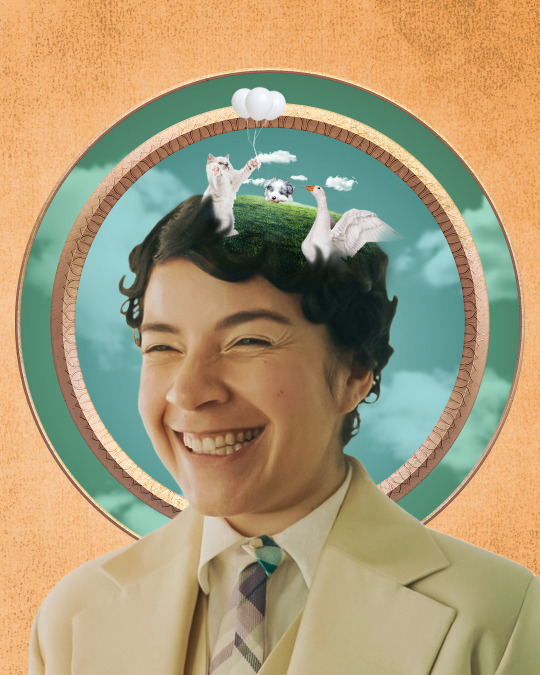
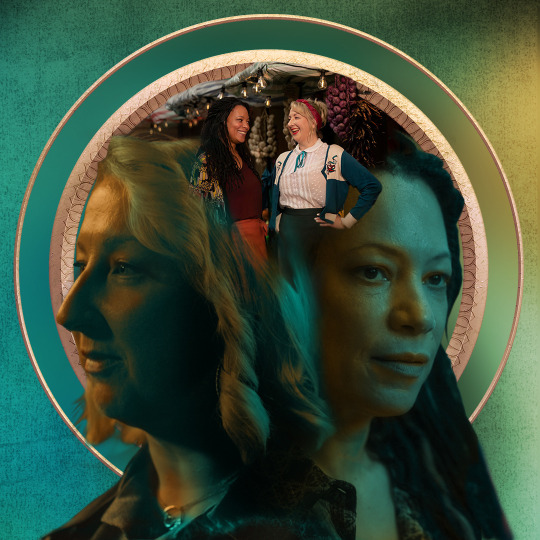
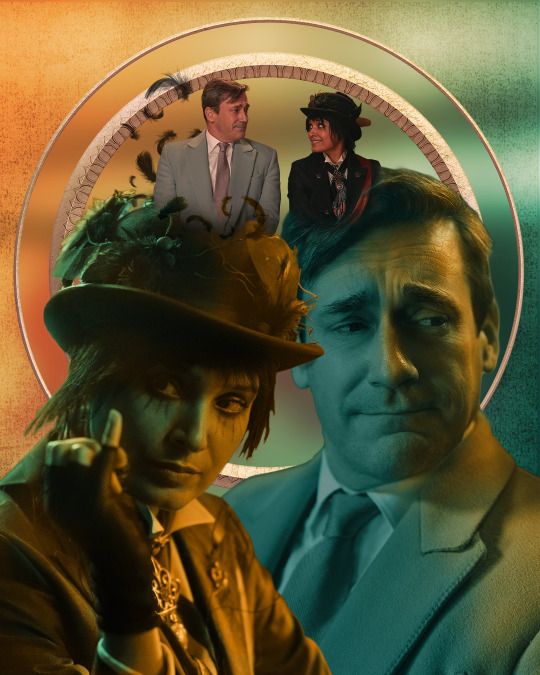
I'm planning on doing individual posts for specific scenes, episodes, and minisodes that require detailed breakdowns. I'll update this list with links as the posts are finished!
POV "Your 'Something's Wrong' Voice"
POV a Trip to Hell and a 25 Lazarii Miracle
POV a Companion to Owls
POV The Dirty Donkey & I think I Found a *Clue*!
POV Bodysnatchers & Cosplaying a bookseller
POV 1941
POV The Ball
POV The End?
Whose POV is it Anyway - a Conclusion
#good omens#good omens 2#michael sheen#david tennant#crowley#aziraphale#good omens meta#crowley x aziraphale#good omens theories#good omens clues#good omens fandom#ineffable husbands#good omens clue#good omens theory#good omens pov#good omens writing#good omens 3#good omens filters#ineffable mystery#ineffable divorce#ineffable spouses#ineffable idiots#ineffable fandom
239 notes
·
View notes
Text
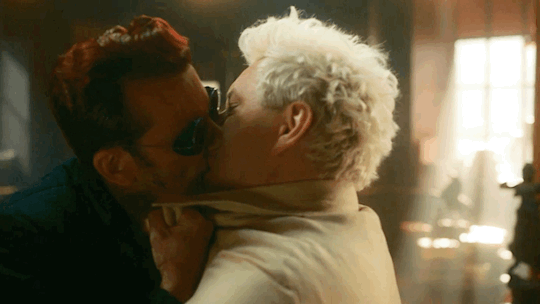






Quiet, Gentle and Romantic Omens - Day 86
Gavin Finney, quoting Douglas Mackinnon, said that they planned to film it « like they are at the center of their universe and everything is spinning around them »
I thought that with this idea in mind, it can at least fit into the romantic (not too gentle and quiet I know)
Master post : here
#good omens#aziraphale#crowley#anthony j crowley#Mr A. Z. Fell#michael sheen#david tennant#😈😇#good omens 2#GoodOmensSeason2Spoilers#GOS2Spoilers#GoodOmens2Spoilers#quiet gentle and romantic#ineffable husbands
394 notes
·
View notes
Text
Foreshadowing, out of order?
In storytelling, is there a single word that means "the opposite of foreshadowing"?
WARNING: in trying to wrap my head around this, there will be wittering!!!
Wikipedia tells me that a flashback is a method of foreshadowing.
The Bullet Catch in the NZF minisode, being a flashback as well as told before the "present day" [speculated] event it sets up a clue for, well, that's what I've understood foreshadowing to mean until now, because isn't foreshadowing always presented before the event it foreshadows comes to pass?

The flashback/memory minisode, A Companion To Owls, is told after the "present day" event it foreshadows. Does that still count as foreshadowing, or is it instead considered "the big reveal" because it is told after?
And is this all that is meant by various things in Good Omens 2 being "out of order"?
The Hiding Miracle and the Memory That Both Foreshadows and Reveals It?
Indeed, it was a tiny miracle - as titled in the soundtrack - that worked as planned and "barely moved the dials" (but still a miracle in which "Noone will have noticed A Thing" however tiny it was, and that "Nobody notices he's here (...) Nobody can spot him, (...) especially if they're looking for him").
I believe it was the first of three events that happened that night, which, became the main focus of this "quiet, gentle, romantic" season, but paling in comparison to the other two events. Moving on!
Returning to how A Companion to Owls isn't told until after The Hiding Miracle and clues us in as to what was actually going on: this tiny miracle was made to appear far more powerful than it actually was, with the use of showmanship:
The ceremonious setup of being positioned on the circle in the middle of the room hidden under the carpet, between Aziraphale and Crowley; he could have been standing, but instead, "Jim... Sit in this chair." And it's a beautiful chair, like a throne, but Jim being taller wouldn't have worked for the image of the 'W' (similar to the 'W' shape made with Shadwell standing between Aziraphale and Crowley at the airbase, in the book Good Omens.)

ta-da!-look-at-this-very-complicated-and-powerful-miracle-that-we-are-doing
Why perform at all then, for an audience of none?
Ah, they're not alone, oooOoOoOOOoOoOooo, spooky. Go and see for yourself: check out the bottom left area of the screen when Crowley returns to the bookshop and says, "I'm BACK" (this is to do with the "framing opportunities" secret mentioned in the Gavin Finney BTS article https://britishcinematographer.co.uk/gavin-finney-bsc-good-omens-2/) Aziraphale calmly replies, "Yes, I can see that" and later gasps, reacting to something happening off-screen at 40m41s.
So this performance, not yet knowing who their audience might be, could be as a precaution, just in case.

Gabriel instinctively crosses his hands and is confused when Aziraphale and Crowley uncross them - or likely because Aziraphale was even standing there at all - because he remembers, or rather, in his mind's eye, sees the shape left behind by a missing piece of furniture.
The ceremonious setup of being positioned in the centre, between Sitis and Job, this time in the background to have Bildad appear a little shorter in height for the stylized 'W', then crossing his hands. The pot containing Sitis and Job's children being the circle, hidden by the circle of carpet (robes) made as Sitis and Job embrace.
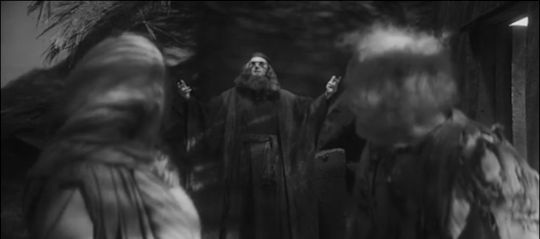
ta-da!-look-at-this-very-complicated-and-powerful-miracle-that-we-are-doing
Had we seen Jim's and Crowley's conversation about memory before The Hiding Miracle instead of much later in episode 5, then it would have been foreshadowing, yes?
*temper rising* A "reveal," or "out-of-order foreshadowing"? (VBUAXNAUSX*keyboard smash*NYVIFGNOMAI) grrrrrr!
...
After the Job story is told, (save for the final scene) and Aziraphale calls for Crowley, my head-cannon used to be that Aziraphale wanted to talk about hair -
Aziraphale: Crowley, I gave you lovely long locks in my retelling of this story, how about you?
Crowley: Nah, "shoulder-length bouncy 'bob'" is what I put - a "Lob" I think is what they're calling it these days.
But now I think that, to book-end Crowley's beginning with, "Your boss said that to Job, do you remember?" (imo they are so good at blending in, they can act human better than any human can act human! So, while feigning the memory span&loss&retention of a human, of course they can remember most everything. Angel stock: constitution of an Ox, memory of an Elephant.) Aziraphale may have wanted to remark on Jim's crossed hands from the night before and how similar it was to Crowley's doing so; that it was evidence of Gabriel still somehow being able to connect with images from his memory. "Crowley? You also did that thing... does Gabriel remember?"
If each minisode contains something that foreshadows or reveals what magic tricks occurred during this season's present day events, I feel that the only thing left is from "The Resurrectionists" minisode, where Crowley Goes Large (woah, woah, woah, another case for The Song Is The Clue?!?) ... or makes himself, something or someone else tiny.
"Size and shape are simply options" after all, so I do wonder about Hell's Usher, where the only time we've seen him is when he is small enough to fit in a bathtub and yet he is HUGE in the opening title sequence of season one. Behind him, Noah's Ark stranded between two damaged buildings (or one damaged building and maybe the Pleasure Cruiser Morbillo?)

Something else that may be revealing of stories yet to be told of the past, while also foreshadowing a near-future event:

Based on what Crowley said, this is not the first time Crowley and Aziraphale have performed a half-miracle together! Whatever biiiig miracle they're about to do (speculated event #2) could still be completely balanced and undetected, but then a plume of miraculous activity emerging from the circle gateway (privately speculated event #3) is what poor Aziraphale will appear to take the blame for.
Things being out of order may have started with the question, are season two's present day events being told out of order? There are other things appearing out of order as well, for example a change in the order of colours in the Rainbow (for "present day" episode two only I think, beginning Violet then Red, etc.) Or, in this case, narrative devices being so intertwined, one flashback-event can contain images and phrases that both foreshadow something yet to happen as well as to reveal what happened in a part of the story already told.
As always, please no asking or tagging Mr Gaiman as this blog post contains theory and speculation, thank you.
#The Hiding Miracle and A Companion To Owls#wittering on#please forgive me#Good Omens 2#foreshadowing#out of order#the big reveal#narrative devices#relearning something forgotten or learning something new? never too late#overthinking technical words and probably VERY wrong about it#Good Omens 2 theory#The Song is The Clue#Good Omens book reference “stylized W”#Tiny Miracle#Crowley Goes Large#“Size and shape are simply options”#Hell's Usher goes large?#Good Omens#Good Omens Opening Title Sequence#Good Omens 3 speculation#first time making GIFs such fun!#good omens meta
105 notes
·
View notes
Text
📢 THIS WEEKEND! 📢
📗 A Nice and Accurate Guide to The Ineffable Con 4 📗
Where: Online
When: Friday 20th to Sunday 22nd October 2023
Why: Raising money for Alzheimer's Research UK in memory of Sir Terry Pratchett and to celebrate all things Good Omens!

📺 What's on? 📺
You can find our programme here: https://www.theineffablecon.org.uk/the-ineffable-con-4/tic4-programme/
We have special guests Peter Anderson, Rory Kurtz, Colin Smythe at Irish Discworld Con, Rob Wilkins, Alzheimer's Research UK, Colleen Doran, Gavin Finney and Sandy Higgins!

❓ What if it's my first time? ❓
All welcome, whether it's your first time or your fourth!
You can check out our FAQs here: https://www.theineffablecon.org.uk/the-ineffable-con-4/tic4-faqs/
You can also drop us a DM if you have any other questions!

⏰ Am I too late to get involved? ⏰
NOT AT ALL!
We are still very much in need of volunteers for games and for support in the lounge!
You can find out more and volunteer here: https://www.theineffablecon.org.uk/the-ineffable-con-4/tic4-volunteer/

🎟 I've got my ticket! 🎟
Remember that you need to have a Zoom account in the same email address as your Con ticket. That will allow you to log in to the Zoom Events platform when the time is right!
You will receive this information by email, too!

💸 Keep an eye out for the AUCTION! 💸
We have nearly 30 lots - a first for TIC! - and all money raised from the auction will be donated to Alzheimer's Research UK.
Check out our recent posts to see some of the goodies coming up and we'll post when it's live for bidding!

🛑 That's all, folks...for now! 🛑
If you'd like to buy a TIC 4 ticket, you can do so here: https://www.theineffablecon.org.uk/events/the-ineffable-con-4/
See you SOON!!!
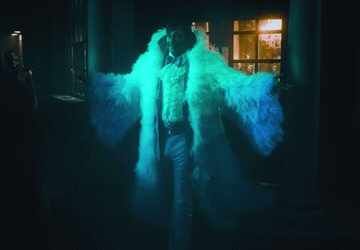
#good omens#ineffable husbands#aziraphale#crowley#the ineffable con#goodomens#conventions#charity#terry pratchett#neil gaiman
225 notes
·
View notes
Text
what's up ! non-exhaustive list of stories featuring weird plants :
The Day of the Triffids, John Wyndham
The Night of the Triffids, Simon Clark
In the Tall Grass, Stephen King and Joe Hill
The Boats of the 'Glen Carrig', William Hope Hodgson
The Man Whom the Trees Loved, Algernon Blackwood
The Red Tree, Caitlín R. Kiernan
Annihilation, Jeff VanderMeer
The Willows, Algernon Blackwood
The Nature of Balance, Tim Lebbon
'Bloom', John Langan
The Ruins, Scott Smith
The Wise Friend, Ramsey Campbell
'The Green Man of Freetown', The Envious Nothing : A Collection of Literary Ruins, Curtis M. Lawson
The Beauty, Aliya Whiteley
The Ash-Tree, M.R. James
Canavan's Backyard, J.P. Brennan
Invasion of the Body Snatchers, Jack Finney
The Hollow Places, T. Kingfisher
'Reaching for Ruins', Crow Shine, Alan Baxter
'Vortex of Horror', Gaylord Sabatini
Hothouse, Brian W. Aldiss
Vaster than Empires and More Slow, Ursula K. Le Guin
Odd Attachment, Ian M. Banks
Deathworld #1, Harry Harrison
The Bridge, John Skipp and Craig Spector
'The Garden of Paris', Eric Williams
Apartment Building E, Malachi King
The Seed from the Sepulchre, Clark Ashton Smith
Rappaccini's Daughter, Nathaniel Hawthorne
The Nursery, Lewis Mallory
The Other Side of the Mountain, Michel Bernanos
The Vegetarian, Han Kang
Sisyphean, Dempow Torishima
The Root Witch, Debra Castaneda
Semiosis, Sue Burke
The Wolf in Winter, Charlie Parker #12, John Connolly
Perennials, Bryce Gibson
Relic, Douglas Preston and Lincoln Child
Gwen, in Green, Hugh Zachary
The Voice in the Night, William Hope Hodgson
Ordinary Horror, David Searcy
The Family Tree, Sheri S. Tepper
The Book of Koli, Rampart Trilogy #1, M.R. Carey
Seeders, A.J. Colucci
Concrete Jungle, Brett McBean
The Plant, Stephen King
Anthologies/collections :
The Roots of Evil: Weird Stories of Supernatural Plants, edited by Michel Parry
Chlorophobia: An Eco-Horror Anthology, edited by A.R. Ward
Roots of Evil: Beyond the Secret Life of Plants, edited by Carlos Cassaba
The Green Man: Tales from the Mythic Forest, edited by Ellen Datlow and Terri Windling
Sylvan Dread: Tales of Pastoral Darkness, Richard Gavin
Evil Roots: Killer Tales of the Botanical Gothic, edited by Daisy Butcher
Weird Woods: Tales From the Haunted Forests of Britain, edited by John Miller
'But fungi aren't plants' :
The Fungus, Harry Adam Knight
Growing Things and Other Stories, Paul Tremblay
The Girl with All the Gifts, M.R. Carey
Mexican Gothic, Silvia Moreno-Garcia
Fruiting Bodies, and Other Fungi, Brian Lumley
'The Black Mould', The Age of Decayed Futurity, Mark Samuels
What Moves the Dead, T. Kingfisher
The House Without a Summer, DeAnna Knippling
Mungwort, James Noll
Fungi, edited by Orrin Grey and Silvia Moreno-Garcia
Trouble with Lichen, John Wyndham
Notes :
all links lead to the goodreads page of the book, mostly because i like to look at book cover art ;
list features authors/books that i love (T. Kingfisher, Silvia Moreno-Garcia, Ursula K. Le Guin, the collections from the British Library Tales of the Weird, etc.), but also a few that i don't like and some that i have not yet read ;
if upon seeing that list the first novel you check out is by Stephen King's you have not understood the assignment ;
not all of those are strictly horror stories, some are 100% science fiction (Brian W. Aldiss' Hothouse for instance).
#text#ramblings#plant tag#botanical horror#last time i posted a list of non-fiction books on the topic. time for some variety
156 notes
·
View notes
Text
I was rewatching Good Omens earlier today and I noticed something thats probably been analyzed before, but I'm a film studies minor thats losing their marbles over this I need to talk about it.
SO I've taken a ton of classes about filming and story telling. And one aspect of story telling I love so much is cinematography (you'll see the cinematographer credited as Director of photography) the purpose of this job to direct lighting, color, and framing during shoots. So whenever you see changes in a shot to any of those things, the cinematographer is the one directing that in order to create a certain feeling for the scene and audience.
why am i telling you all that? Because the director of photography on Good Omens (Gavin Finney) achieved something that has me climbing the walls. In the first season when Crowley and Aziraphale are having a "breakdown" in their relationship under the band stand in the park each time it cuts between them something changes in the framing. When we are looking at Crowley from Aziraphales POV, Crowley seems farther away in the shot. And when we are looking at Aziraphale from Crowley's POV Azi is closer. Then we see this framing again in season 2 during the confession scene. Azi looks much closer from Crowleys POV and Crowley is much farther to Azi.
The number one thing I've learned through out my film classes is when you are framing someone in your shot you have to show what's most important to your character, show don't tell. The purpose of that is a great story should be able to be told without sound, so showing emotion and feeling in the way you frame shots is important.
So what are the feelings in these frames? Crowley wants Aziraphale to be close, for Azi to just accept their love, to stop pushing him away, and be together. Each time they've had these confrontations Crowley is always the one wanting to be closer. While Crowley in Aziraphales eyes need to be farther away, stop getting closer, and only sees them as an Angel and Demon who are on opposite sides (lets be honest Azi you are fckn SMITTEN with Crowley). In the second season the feelings have changed but in the end it still hurts the same. They are important to each other but have different ideas of what their love/relationship should be. I think in order for the framing in each others eyes to be balanced they'll need to stop talking AT each other and start talking TO each other.
Anyway there are my two cents I could add more but it hurts to think about. (I'll think about it the more I watch honestly so more might be added.)
#Excuse all my grammar mistakes I'm too lazy to correct anything#as long as you can read and understand it lol its always appreciated when anyone reads my takes.#good omens#good omens 2#aziracrow#ineffable husbands#could this be considered meta?#its more of an observation based on skills I've acquired.#nobie does stuff#txt post
178 notes
·
View notes
Photo



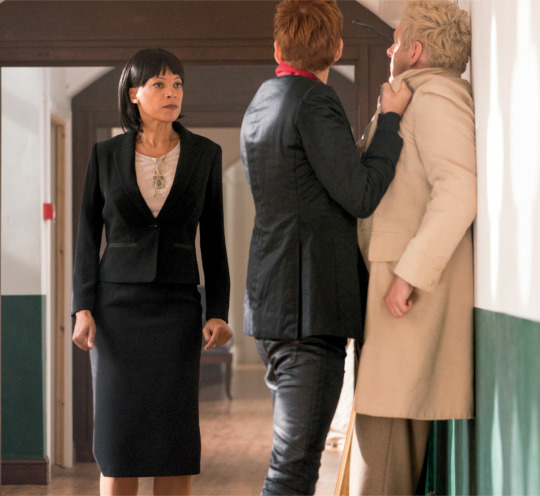



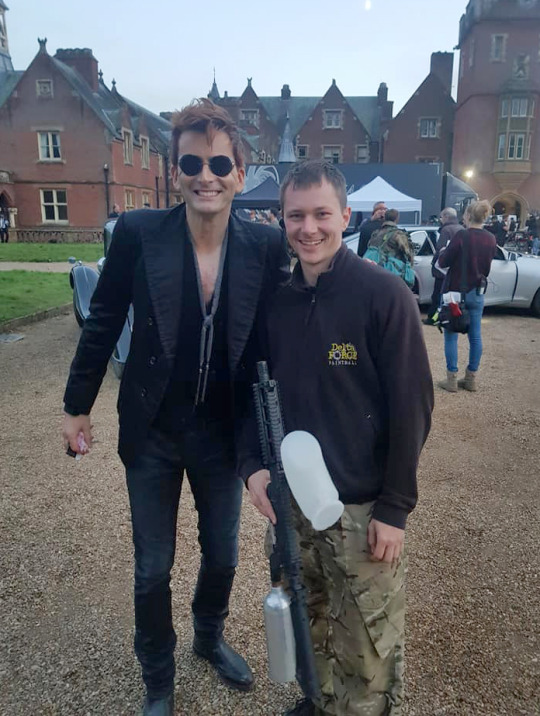
Good Omens - Behind the Scenes at Tadfield Manor
Excerpt from The Nice and Accurate Good Omens TV Companion:
Eleven years later, on his return to the scene of the diabolical switcheroo, this time with Aziraphale in tow, Crowley finds himself in a very different setting. Gone are the Satanic Nuns of the Chattering Order of St. Beryl’s and their movements in the shadows. Now, with St. Beryl’s never having risen from the ashes, they find the building transformed. Instead, the demon and his angelic associate walk into Tadfield Manor, which has been converted into a venue for office teambuilding away days. Across the manor grounds, an interdepartmental paintball skirmish is in full swing. Naturally, in the presence of such entities, the exercise becomes something altogether more dangerous and deadly.
“Michael Ralph [production designer] did a fantastic job of transforming the forecourt outside the building by dressing it as a battle zone,” says [first assistant director] Cesco Reidy. “We had military vehicles, camouflage nets and an obstacle course. It really was fit for purpose as an adventure playground for grown-ups with guns.”
In order to make the most of the conflict and the chaos that ensues, Douglas Mackinnon and the director of photography, Gavin Finney, called in the high-speed Phantom camera.
“You see it used on football replays, shooting a ridiculous number of frames per second,” explains script supervisor Jemima Thomas. “We wanted to see the paintballs flying as Crowley and Aziraphale walk through in super slow mo, and we staged and choreographed it carefully so they didn’t get splattered.”
While the pair depart without a mark on them, leaving bedlam in their wake, there’s no escaping the enormity of the task they face. For the Antichrist is missing, and Armageddon a matter of days away.
#david tennant#michael sheen#good omens#ineffable husbands#crowley and aziraphale#because I love behind the scenes stuff#and my fingers are crossed for even more goodies with season 2#oh the hours we could spend talking about the hallway/wall scene#stuff i posted#goBts
864 notes
·
View notes
Text
RP Request!
Hello! This is my first time requesting ROleplays on Tumblr so be patient with me!
I can RP either on here or on Discord (feel free to DM for Discord info). I prefer partners who are over 18 (I'm 20 so this is for my comfort)
Characters I play as will be written in bold (Ex. Steve X Eddie)
Stranger Things:
-platonic! Will Byers & Eleven
-platonic! Eleven & Henry
-Plantonic! Billy Hargove & Max Mayfield
-Steve Harrington X Eddie Munson
-Eddie Munson X Billy Hargrove
-Steve Harrington X Billy Hargrove
-Will Byers X Mike Wheeler
-Will Byers X Gareth
-Jonathan Byers X Argyle
-Eleven X Max Mayfield
-Nancy Wheeler X Billy Hargrove
-Eddie Munson X Chrissy Cunningham
-Lucas Sinclair X Will Byers
-Lucas Sinclair X El
-Lucas Sinclair X Max Mayfield
The Black Phone
-Robin Arellano X Finney Blake
-Vance Hopper X Bruce Yamada
Detroit Become Human
-Rk900 X Gavin Reed
Harry Potter/ The Marauders
-Sirius Black X Remus Lupin
-James Potter X Regulus Black
-Harry Potter X Draco Malfoy
-Harry Potter X Fred Weasely
- Harry Potter X George Weasely
Criminal Minds
-Spencer Reid X Derek Morgan
-Spencer Reid X Aaron Hotchner
#Stranger Things Rp#stranger things#criminal minds#the black phone#harry potter#the marauders#detroit become human#wolfstar#harringrove#hellcheer#steddie#byler#rk900#moreid#discord rp#roleplay request
31 notes
·
View notes
Text


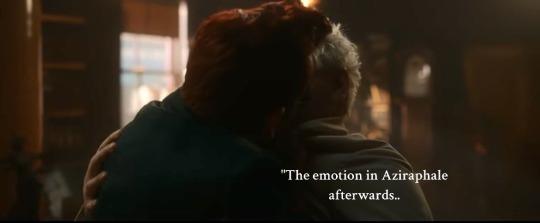
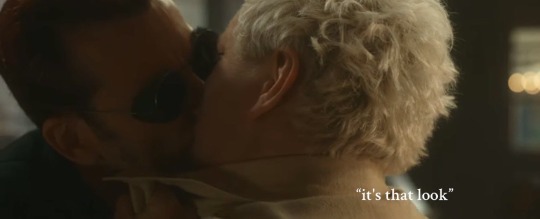
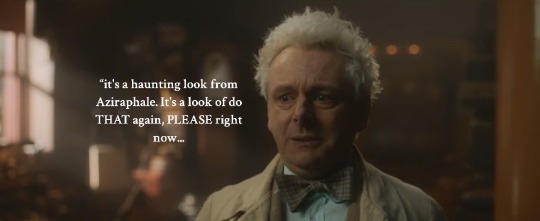
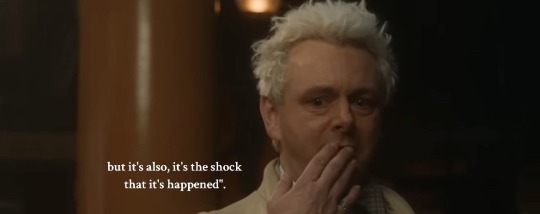
Good Omens 2 final 15 + quotes to describe that scene from the Ineffable Con 4.
#good omens#aziraphale#crowley#ineffable husbands#neil gaiman#terry pratchett#good omens fun facts#good omens 2#easter eggs#rob wilkins#gavin finney#rob wilkins was insane when he said this
211 notes
·
View notes
Note
Hi! Do you happen to know where the 537 AD scene of "Hard Times" was filmed or what castle that is in the background? (Or if it's a fake green-screen castle?) I can't seem to find anything about it. Thanks!!!!
Hiya! :) In the Good Omens Companion there is:
In considering a favorite moment from the pre-title sequence, Gavin Finney smiles broadly. “Arthurian England,” he says, referring to one of the scenes shot in the UK. Gavin’s pick opens with knights in armor on horseback staging a face off. “It was so thick with smoke that Aziraphale and Crowley can hardly see each other. We made it part Excalibur and part Monty Python.”
In shooting such a large-scale scene, first assistant director Cesco Reidy notes that one element proved to be a happy accident. “While we had to cover a large area with fog, which was a practical challenge to get the consistency of the look, we found that a water tower in the background looked like a turret from some huge unseen castle if we lined up the camera in a particular way. There was no need to add anything to it,” says Cesco. “It looked the part.”
It's a water tower (somewhere in England :), don't know it they elsewhere mentioned where).

That then has been CGIed to look like a castle :)
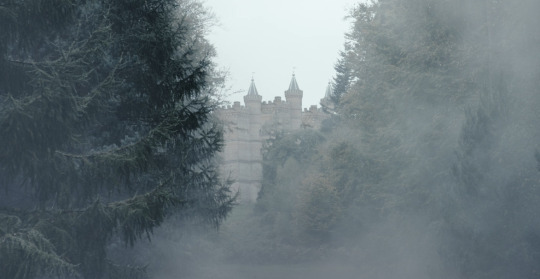
169 notes
·
View notes
Text
Gavin Finney Revelation #2
The complicated camera move was supposed to be a 360 degree rotation, to show that their world was spinning.
They decided that that would actually take us out of the moment. They instead wanted us to focus on the moment.
"Let's just sit and watch it"
"Sometimes I sneakily zip through to that moment"
53 notes
·
View notes